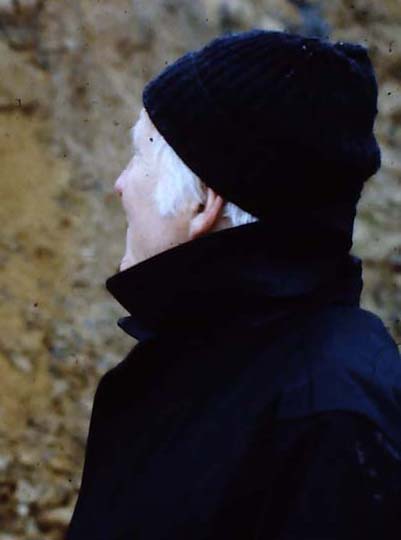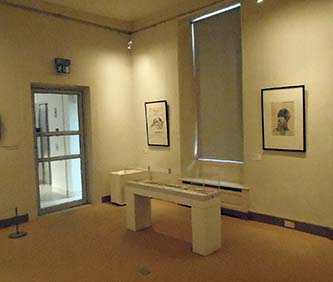I
want to collate all this material that has built up over thirty years
at the time when I am nearly at the exact age Nigel
was when in 1983
we stood in the Serpentine Gallery in front of his Headlands work.
He was not happy despite the efforts taken by the Gallery with his work.
One of his best friends had died at the age of 65 and he suspected
he was similarly doomed.In fact he was to get an extra three years.
I
had just conducted an Artist meets the Public event with him at the
Serpentine. Oriole Mullen was there in support. My sister-in-law Emma
Kirkby had heard I was in town and sweetly swelled the audience with
several members of the Consorte of Music. Nigel had been at his
most benevolent and reflective in the first ten minutes. I asked about
his association of green and dead flesh in the Single Heads. He talked
about working on a Baroque portrait with the chief restorer Helmut
Ruheman at the National Gallery London in 1939, to find the underpainting
for the flesh tones was realised in green pigment, its complementary
colour. The audience hummed with interest. I found it odd this fascinating
aside had been concealed until long after I could have used it in
the catalogue.
Then
the saloon doors swung open. Eduardo Paolozzi appeared
at the back of the room, completely throwing Nigel. After years of
collaboration, fascination and mutual delight, their relationship
had fractured and soured for reasons now pointless to probe. Nigel
glared at his old friend who had unfurled a large Tube map in the
back row and was pointedly scrutinising it in the company of a young
man with wire framed glasses. Nigel now refused to string words into
sentences and I was left blathering as sweat slowly rolled down my
flanks. Paolozzi left before the end of the event so I didn't
get to discover what I had got myself into.
What the fuck was that? I asked Nigel.
The Cunt,
he said through gritted teeth.
The Serpentine
show Headlands,with its emphasis on Landscape
offered him the opportunity to strut his stuff in the Metropolis, and
its critical failure deeply wounded him. Only
now, re-reading texts and subsequent critical response do I see how
much his heart was broken. He was a hard man and the disappointment
had to be managed carefully.
How had
this all started? Nigel had agreed to a major show at the Norwich
School of Art to be held in 1983. He had been Head of Photography
twice there, seemingly drifting in and out of administrative duties.
I was a visiting lecturer in what was called Complementary Studies,
known for my florid and persistent lecturing. I had dropped in from
time to time on studio lunches with Derrick Greaves and Nigel
when fine wines and food sustained visitors during most of the afternoon.
I loved the campy patois of sudden cries of "Dommage..." and
"Quelle Elan.." Terribly Rive Gauche I
thought. Nigel's studio was less attractive being in the basement,
next to the Boiler Room and giving the impression of being underwater,
the River Wensum lapping at his sill.
So Lynda
Morris curated, Bruce Brown designed the catalogue, Bill English
wrote the standard introduction. Derrick contributed a gem
of descriptive prose on Nigel's disfiguring the
printed pages of his books. After a few weeks of
guarded interchange, Nigel decided he would enter into the spirit
of the exhibition and answer questionnaires I sent to him. This was
the breakthrough. He was at his best in this considered and rounded
response. I went over to his studio on several occasions, once with
Oriole. Then on one occasion when I was promised access to the tea
chest of unshown work in the studio. I had a hangover of huge proportions
and went for a walk instead when I threw up on the Dyke and not in
the tea chest. Janet Henderson was a source of constant delight in
our meetings , with an amusing glare as Nigel's claims of ownership
of the garden and its contents became increasingly inflated.
I thought
I had done the decent with the exhibition texts for Norwich, our outings
to the various points of call of the exhibition through provincial
art galleries (being what he called the Prisoner's Friend at Southampton,
Colchester as well as the Serpentine) and the film for Cologne TV.
We had got on famously, and he trusted me to be part of his options
when the call from posterity came calling . Only he (and probably
Paolozzi) knew how much he had accomplished, how much he had guided
and inspired others particularly a slightly younger generation than
his in the post-war period of austerity and cultural conservatism.
By the
very nature of his working practices during the later years he was
isolated and in many ways believed the work was good enouigh to make
its own way without his active interventions. By the time he realised
that he was being just too fastidious it was too late, He knew he
was going to be relegated to the Lower Divisions of the Hierarchy
in Brit Art. What a fate.
The next
time I worked with Nigel was a reprise of the role of the Prisoner's
friend. Tim Rayner was a film director operating out of Norwich doing
a series of English language films for Cologne TV. By clever editing
it appeared Nigel was a Norwich lad with a studio round the corner
from the Art School whereas he was two hours away by train on the
Essex Marshes. Nigel and I were seen in solemn conclave in the Norwich
Art School Gallery in front of Duchamp's Dust Breeding which
had been such a key influence on the young Henderson. I remember
Nigel's cut-off line about his attitudes to art, "No scholar
I." Such
timing. Such economy of effort.
Another
day's shooting has been arranged at Nigel's studio. Neither of us
could work out how we were to be paid. At the end of the shoot the
Sound Man opened his wallet and did the decent. Nigel was superb.
He was articulate and measured in appraising his own work. He talked
to camera but his eyeline directed to me out of shot. How far his
performance was an aid to the teaching of English as a Foreign language
I cannot say. He certainly taught me a lot that day - at home- surrounded
by his works, the talismans and tearsheets of his obsessions. He
teased sections of Satie's Gymnopedies out of an old piano. He
perched on a high stool in the milky studio light.
They
filmed him striding out with dogs in the landscape. I was shocked
he'd even allowed himself to be filmed without his top set of dentures,
gurning into the camera. More informatively he'd even hacked up
a photograph of a section through a red cabbage, cutting into
a large photographic self portrait to allow a glimpse into his collage
techniques.
We did
another Box and Cox for Robert Short and the Norfolk and Norwich
Contemporary Art Society on its acquisition of Willy Call Up.
But I
didn't seem to see Nigel much after the Serpentine show. Who rang
? I can't remember but I was told that Nigel had come down to breakfast
at Landemere Quay, prepared a full English breakfast and dropped
dead. What seemed like weeks later I was in a car heading for the
Ipswich Crem with Lynda Morris, Derrick Greaves and Mel Clark. How
I found myself hosting the funeral is already here at  . The
success of my schtick can be judged by repeat performances
at the funerals of Grahame White and David Watkin. I became what
Phil Beard called the Jack Dee of the Funerary Experience. . The
success of my schtick can be judged by repeat performances
at the funerals of Grahame White and David Watkin. I became what
Phil Beard called the Jack Dee of the Funerary Experience.
There
is no point making claims for Nigel and his art. No revival of interest
flared after his death, or after Victoria Walsh's book and exhibition
in 2001. I make available here for the first time his questionnaire
responses from which you will gauge for yourself the fizz and originality
of the Man. Ultimately it means little that the art world underestimated
him. I delighted in his company. He enjoyed the interchange of
collaboration, despite his hermetic leanings. His ear for language
and calculation with words was unique and I treasure memories of
him.
He would
thrust an image across the table. "What do you make of that?" His
pleasure was that, no matter what association or narrative I discovered, he
always claimed it was nothing he hadn't already pondered. And I believed
him.
|



